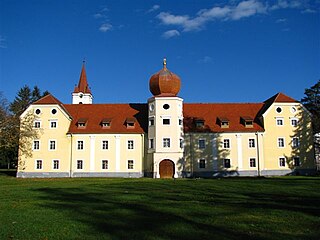Ždralovi | |
|---|---|
Village | |
| Coordinates: 45°53′N16°52′E / 45.883°N 16.867°E Coordinates: 45°53′N16°52′E / 45.883°N 16.867°E | |
| Country | |
| County | |
| Municipality | |
| Population (2021) | |
| • Total | 1,311 |
| Time zone | UTC+1 (CET) |
| • Summer (DST) | UTC+2 (CEST) |
Ždralovi | |
|---|---|
Village | |
| Coordinates: 45°53′N16°52′E / 45.883°N 16.867°E Coordinates: 45°53′N16°52′E / 45.883°N 16.867°E | |
| Country | |
| County | |
| Municipality | |
| Population (2021) | |
| • Total | 1,311 |
| Time zone | UTC+1 (CET) |
| • Summer (DST) | UTC+2 (CEST) |
According to the 2021 census, its population was 1,311. [1] It was 1,423 in 2011. [2]

Krapina-Zagorje County is a county in northern Croatia, bordering Slovenia. It encompasses most of the historic region called Hrvatsko Zagorje.

Virovitica-Podravina County is a northern Slavonian county in Croatia. Its county seat is in Virovitica and it includes the area around the Drava river, hence the name Podravina. Other notable towns are Slatina and Orahovica.

Požega-Slavonia County is a Croatian county in western Slavonia. Its capital is Požega. Its population was 78,034 at the 2011 census.

The Dubrovnik-Neretva County is the southernmost county of Croatia. The county seat is Dubrovnik and other large towns are Korčula, Metković, Opuzen and Ploče. The Municipality of Neum, which belongs to neighbouring Bosnia and Herzegovina, divides the county in two parts which are connected only by the Pelješac Bridge. The southern part of the county consists of Dubrovnik and the surrounding area, including the Pelješac peninsula, and the islands of Korčula, Lastovo, Mljet, Šipan, Lopud and Koločep. The northern part of the county includes the Neretva Delta, the Baćina lakes north of Ploče, and a swath of hinterland near the southernmost slopes of Biokovo and around the hill of Rujnica. The northern part of the Mljet island is a national park. The Lastovo archipelago is a designated nature park. The southernmost tip of the county is the Prevlaka peninsula at the border with Montenegro. It is the only Croatian county that borders Montenegro.

Bjelovar is a city in central Croatia. It is the administrative centre of Bjelovar-Bilogora County. At the 2021 census, there were 36,433 inhabitants, of whom 93.06% were Croats.

Otok is a town in eastern Croatia, located 20 km south of Vinkovci, in eastern Slavonia. The settlement gained the status of town by the decision of the Parliament of Croatia on July 13, 2006. At the time, nearby Privlaka was a part of the municipality, but was subsequently declared a municipality in its own right. The population of the town of Otok is 6,343, with 4,694 residents in Otok itself and 1,649 in the nearby village of Komletinci. In the census of 2011, 99.31% of the population declared themselves Croats.

Županja is a town in eastern Slavonia, Croatia, located 254 km east of Zagreb. It is administratively part of the Vukovar-Syrmia County. It is inhabited by 12,090 people (2011).

Brezovica is a city district and a settlement part of Zagreb, Croatia, located in the southwestern part of the city. The district has a total population of 12,030 inhabitants, while the settlement itself has a population of 594.

Donji Miholjac is a town in the Slavonia region of Croatia, on the river Drava and the border with Hungary.

Kutjevo is a town in eastern Croatia. It is located in the Slavonia region, northeast of town of Požega.

Ivankovo is a village and a municipality in the Vukovar-Syrmia County, Slavonia in Croatia. It is located approximately 10 kilometres west of Vinkovci.
Popovača is a town in Croatia in the Moslavina geographical region. Administratively it is part of the Sisak-Moslavina County.

Vrgorac is a town in Croatia in the Split-Dalmatia County.

Gornji Kneginec is a village and municipality in Croatia in Varaždin County.
Berek is a municipality in Bjelovar-Bilogora County, Croatia.

Pregrada is a town and municipality in Krapina-Zagorje County in Croatia. In the 2011 census, there were 6,594 inhabitants in the following settlements:

Andrijaševci is a village and a municipality in Vukovar-Syrmia County in eastern Croatia. Despite its name, the seat of the municipality is in the village of Rokovci.

Štikada is a village in the Lika-Senj County, Croatia. The settlement is administered as a part of Lovinac municipality.

Women in Croatia form half the population and in modern Croatian culture they are largely equal to men.